Sedges: An introduction
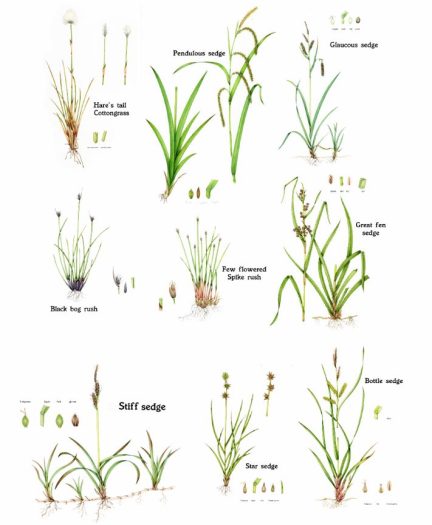
I frequently get asked to illustrate plants which many see as a little dull, and one of these families is the sedges (Cyperaceae). Sedges, however, are far from dull but are elegant and beautiful plants. Perhaps all it takes to make people love them is a little information on their anatomy and diversity?
Like grasses and rushes, they are monocots, but are a distinctly different group of plants. Here is a beginners guide to the Sedges. (For a beginner’s guide to the Grasses, please click here. For a guide to the rushes follow this link.)
Anatomy of sedges
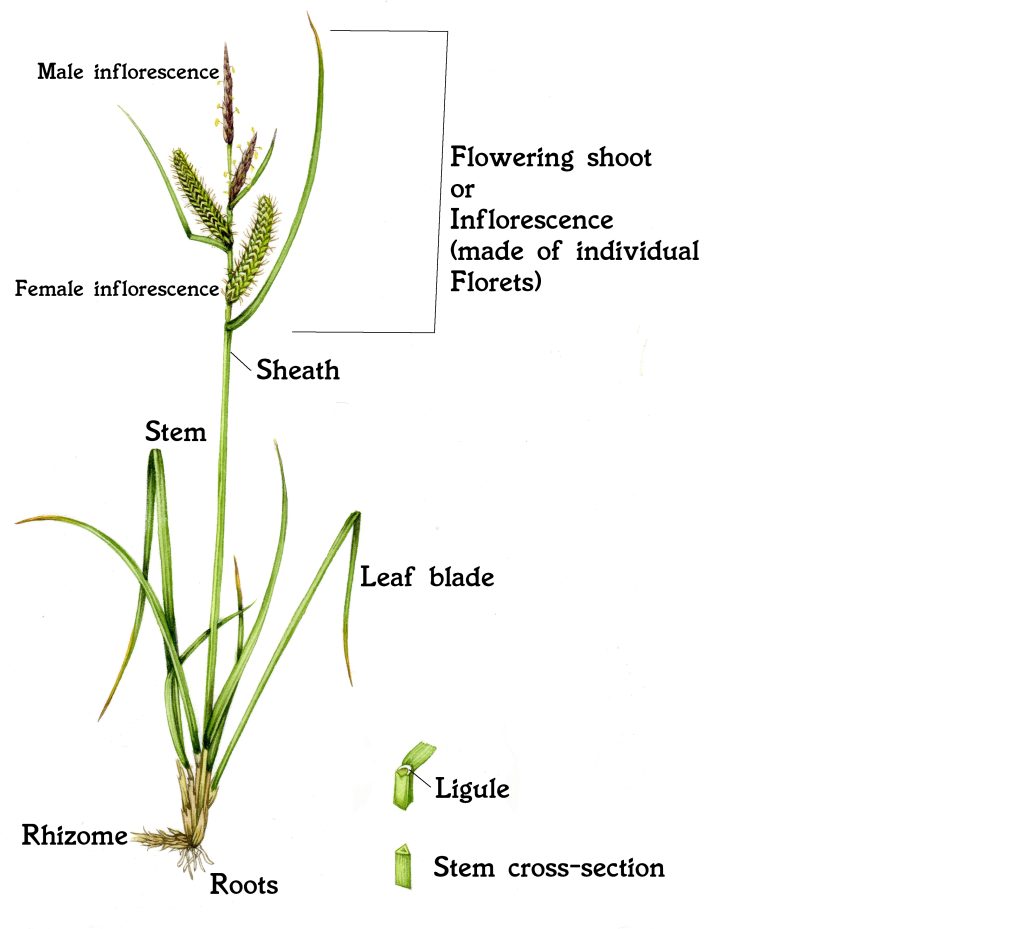
Anatomy of the Common sedge Carex nigra
Vegetative Features of Sedges
The first and easiest way to spot a sedge is by looking at its stem. Sedge stems are solid, and unlike grasses, they don’t have nodes or joints. Sedge stems are triangular in cross-section, three sided, especially towards the base of the stem. In general they are tough and wiry.
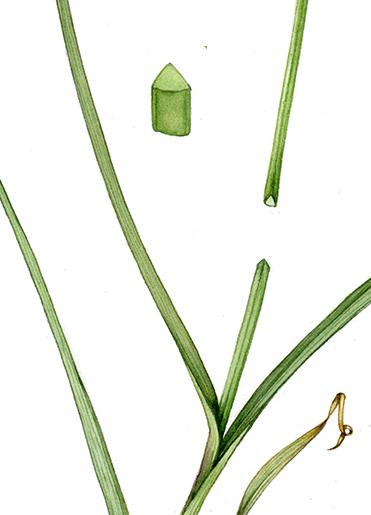
Sedge stem of the Greater tussock sedge Carex paniculata, showing it’s triangular shape.
Leaves are similar to grass leaves, being formed from a blade, a sheath (the hollow tube below the blade that encloses the stem), and a ligule (a membranous flap at the junction of the blade and the sheath).
Leaf shape varies enormously between species. Some leaves are needle like, some have spikey points, some have hollow tips, some are broad and flat, some have smooth edges while others are toothed, in some species (Like the Deer–sedges) the leaves are reduced to tiny flaps, and in others (like the spike rushes) there are no leaf blades at all, just a sheath. Colour differences are rife too, from yellows through vivid greens to glaucous, almost blue shades.
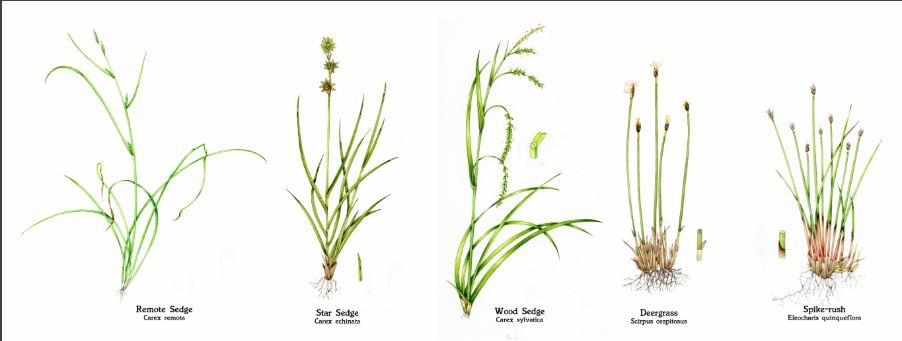
Sedge leaf variety
Unlike grasses, sedge ligules are fused to the base of the leaf blade. Below is a range of sedge ligules. As with grasses, these can be used to identify different species.

Variety of different ligules seen in different species of Sedge
Sedge growth habit
Size and growth form varies in sedges, and both are an important way of telling species apart. The growth patterns relate to the way shoots grow from rhizome (the underground and horizontal stem).
Some will grow in dense tussocks, like the Greater tussock sedge Carex paniculata. Other tussocky sedges include the Schoenus and Trichophorum species.
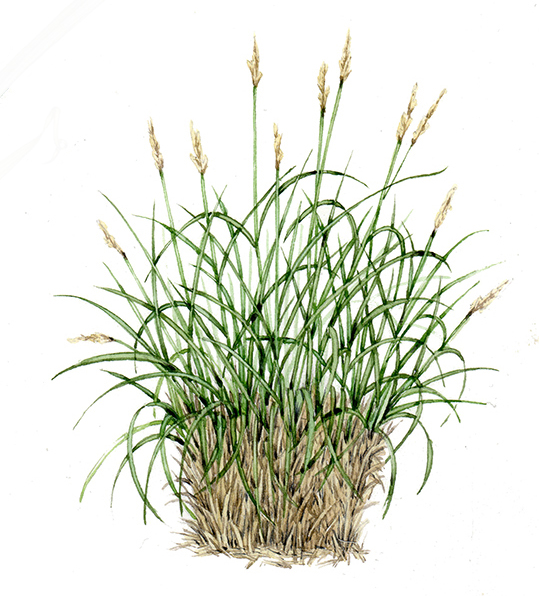
Sedge Greater tussock sedge Carex paniculata showing its tussocky growth habit
Other species show different growth patterns from the rhizome, putting up shoots which are close to one another, and which radiate from the centre. The Few flowered spike rush Eleocharis quinqueflora is a good example of this, as are the Isolepis species.
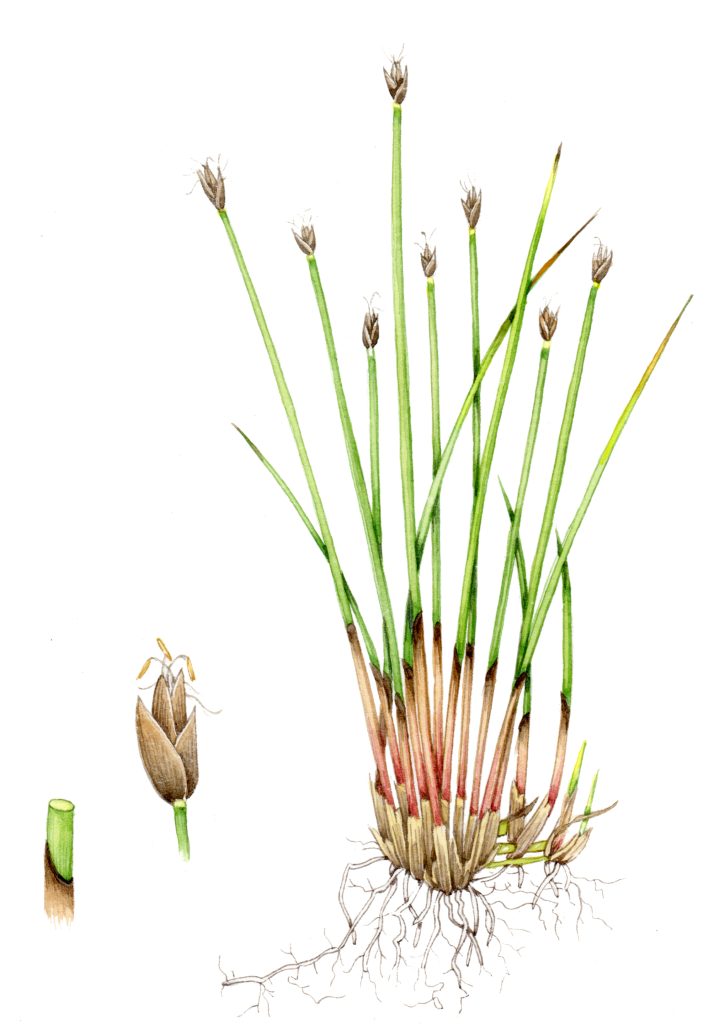
The Few Flowered Rush Eleocharis quinqueflora
In other sedges, there’s far more space between the shoots coming up from the rhizome, which leads to the plants having a creeping habit. They’re sometimes referred to as “stoloniferous” which gives a good clue to their growth, even though it’s technically not quite right (unlike the stolons of grasses, rhizomes contain food supplies). Lots of sedges grow like this, like the Stiff sedge Carex biglowii.

Shoots growing up from along the rhizome; Stiff sedge Carex biglowii
For more on these differences in rhizome growth, consult the bible for sedge enthusiasts, Sedges of the Birtish Isles by Jermy, Simpson, Foley & Porter (p. 5-6) There’s also information on how the rhizome itself can be used to tell species apart, by seeing whether it’s woody or not, and by looking at the leaf scales that grow from it.
Flowers of Sedges
The flowers and fruits of sedges are markedly different to those of grasses. They take a little getting used to. As with many areas of botany, they have nomenclature specific to their family.
Sedge flowers are known as Inflorescences. They are made of lots of smaller florets. Like grasses, they are wind pollinated.
These florets are grouped together into cylindrical or oval clusters which are known as Spikes or Spikelets.
These spikelets are arranged differently, according to species. They can be solitary, un-branched and at the tip of a stem. Or they can be arranged in groups, into branching flowering heads. There may be bracts below the spikelets. The form and length of these bracts is important when telling species apart.
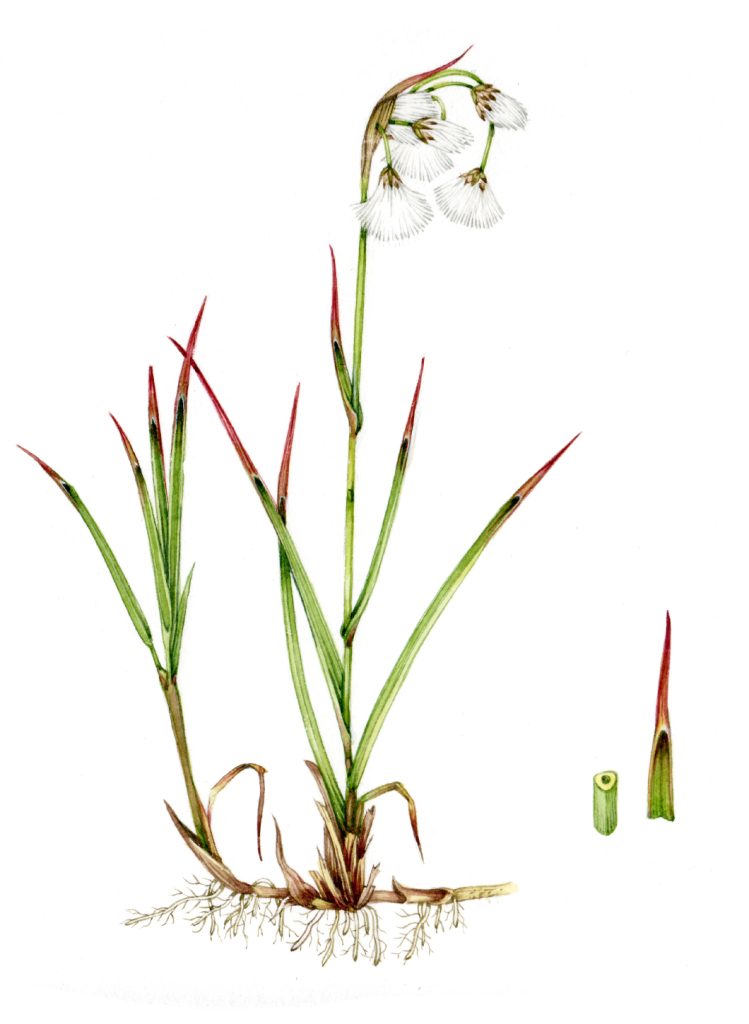
Common cottongrass Eriophorum angustifolium has a branched flowering head.
The Few-flowered Spike-rush Eleocharis quinqueflora has solitary spikelets borne at its tips (see picture above).
Bisexual sedge florets
Across the sedge species, each floret is tiny, and grows in the junction between the stem and a tough scale called a glume. Many sedge florets are bisexual, bearing three stamens (with stiff filaments bearing anthers), stigmas (less feathery than in grasses and varying from 2 to three depending on species), and an ovary inside a covering; this unit is known as the utricle.
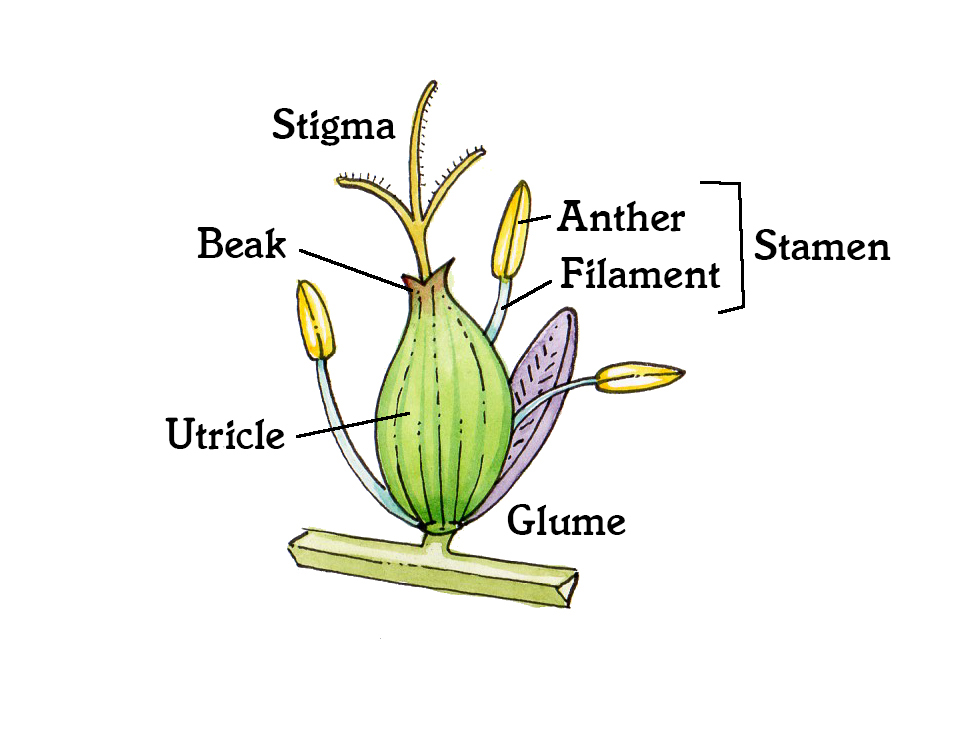
Diagram of a bisexual sedge flower
This diagram shows the anatomy of a bisexual sedge flower. The utricle encloses the ovary (and eventually encloses the fertilized fruit, known as a nutlet) and may have a pointed tip or beak.

The Great fen sedge Cladium mariscum has bisexual flowers and a branching inflorescence. Bisexual flowers can also be borne in non-branching inflorescences (as in the Black bog rush Schoenus nigricans below)
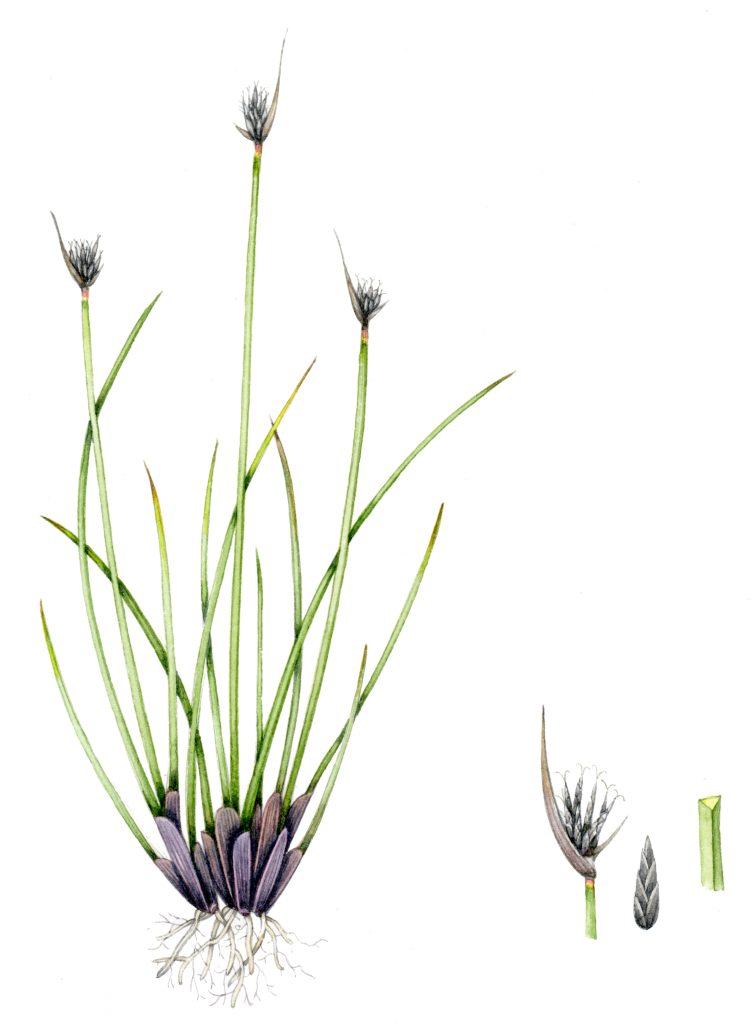
Bisexual florets on the Black bog rush Schoenus nigricans
Unisexual sedge florets
However, the florets of the Carex (true sedges) and Kobresia (false-sedges) families are unisexual, meaning the male and female flowers are separate.

Diagram of a unisexual male sedge floret
Male flowers have three stamens and a glume. In male spikelets, the lower male flowers may be sterile and have larger glumes.
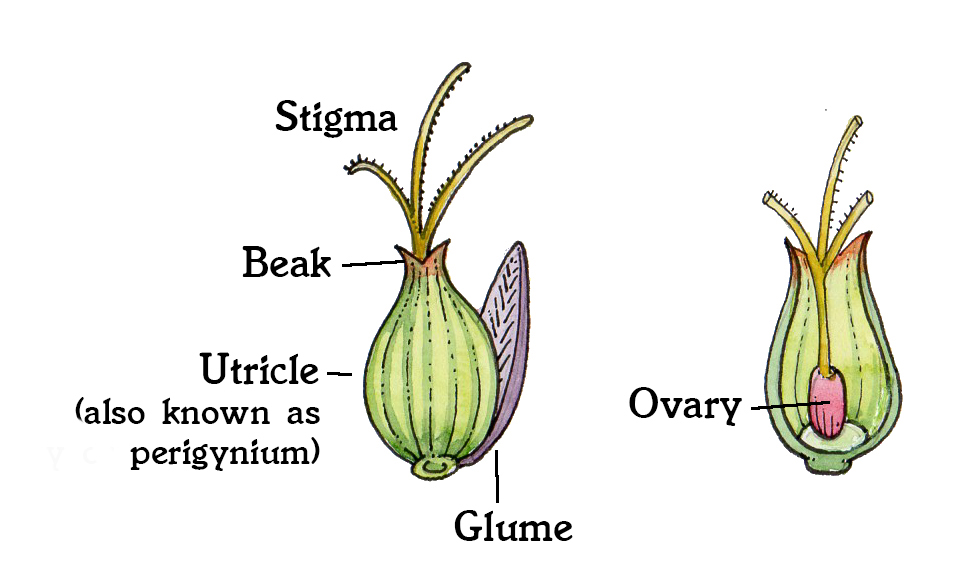
Diagram of a unisex female sedge floret
Female florets have a bottle-shaped utricle with a glume below. In some species there are two stigmas on the utricle (like the Stiff sedge Carex biglowii and the Common sedge Carex nigra) and these tend to mature into a flattened curved nutlet.
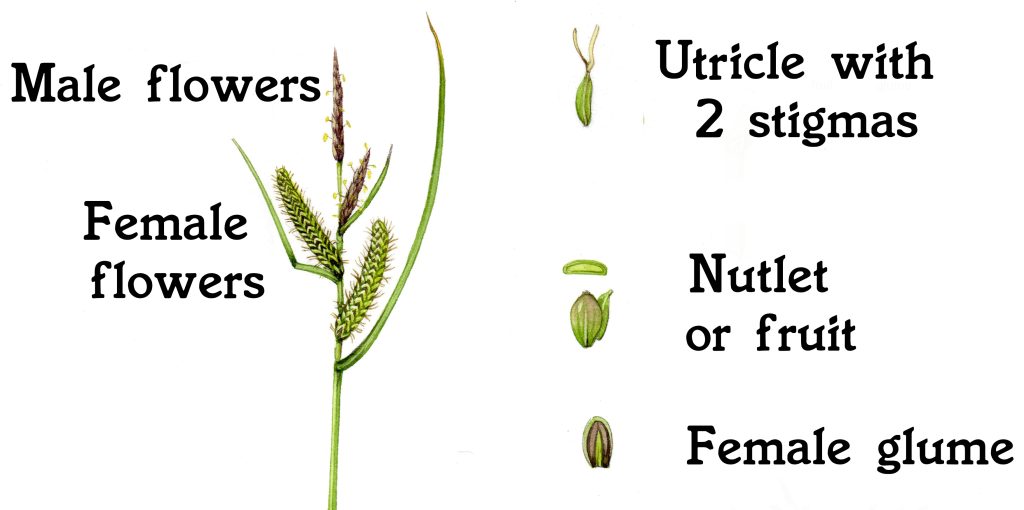
Sedge with two stigmas Common sedge Carex nigra
In other species there are three stigmas per utricle (as with the Carnation sedge Carex panacea); these tend to mature into a rounded or somewhat triangular nutlet.
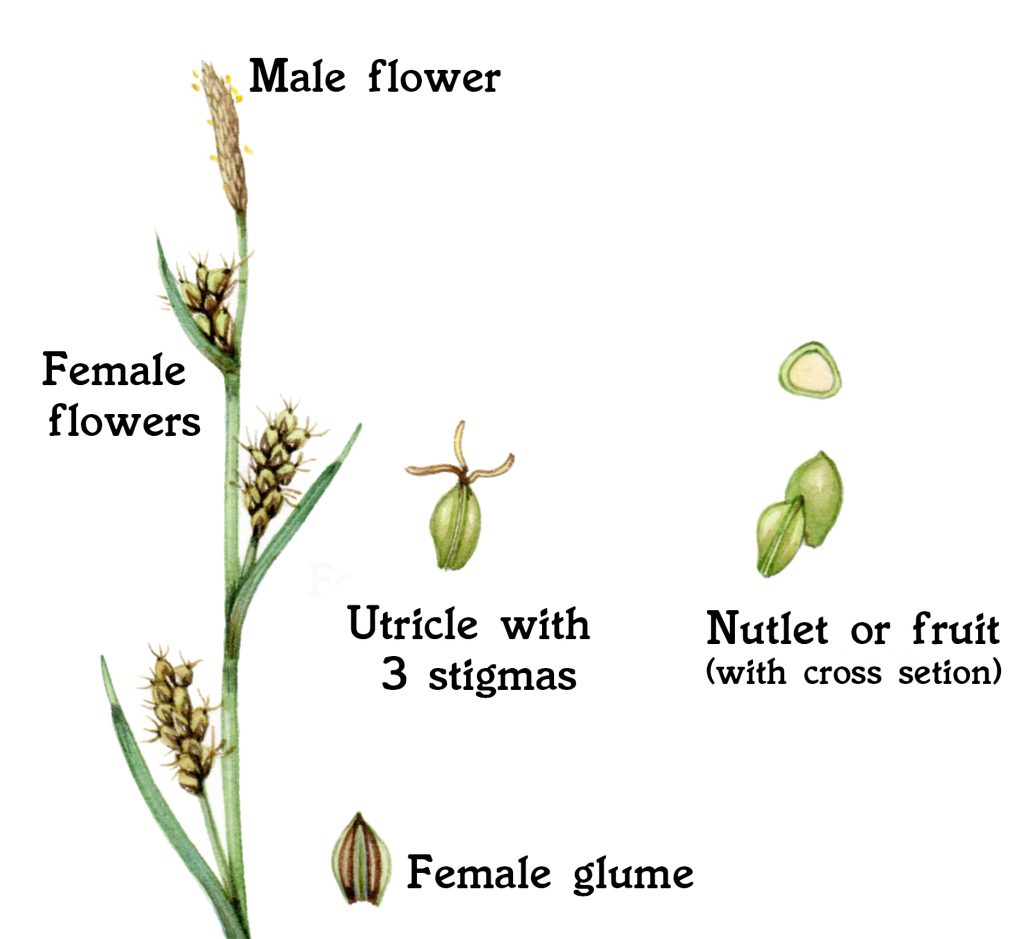
Sedge with 3 stigmas Carnation sedge Carex panacea
Although sedges with unisexual flowers may have only all-male-floret or only all-female-floret spikelets, this isn’t always the case. In some species the spikelets of both sexes are carried on the same plant, with all the male flowers at the top and female ones at the bottom (androgynous), or vis a versa.
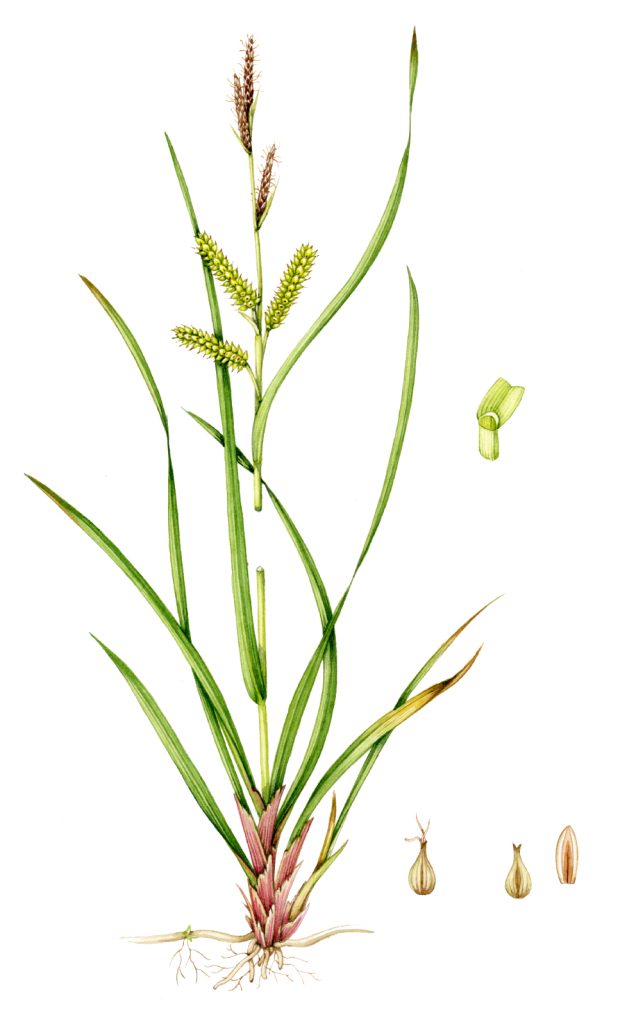
Bottle sedge Carex rostrata has unisex florets and bears thin male spikelets above the female ones, and thus is androgynous.
In the Diocecious sedge Carex dioica, male flowers are carried on one plant with the female spikelets on another (the clue is in the name, I suppose).
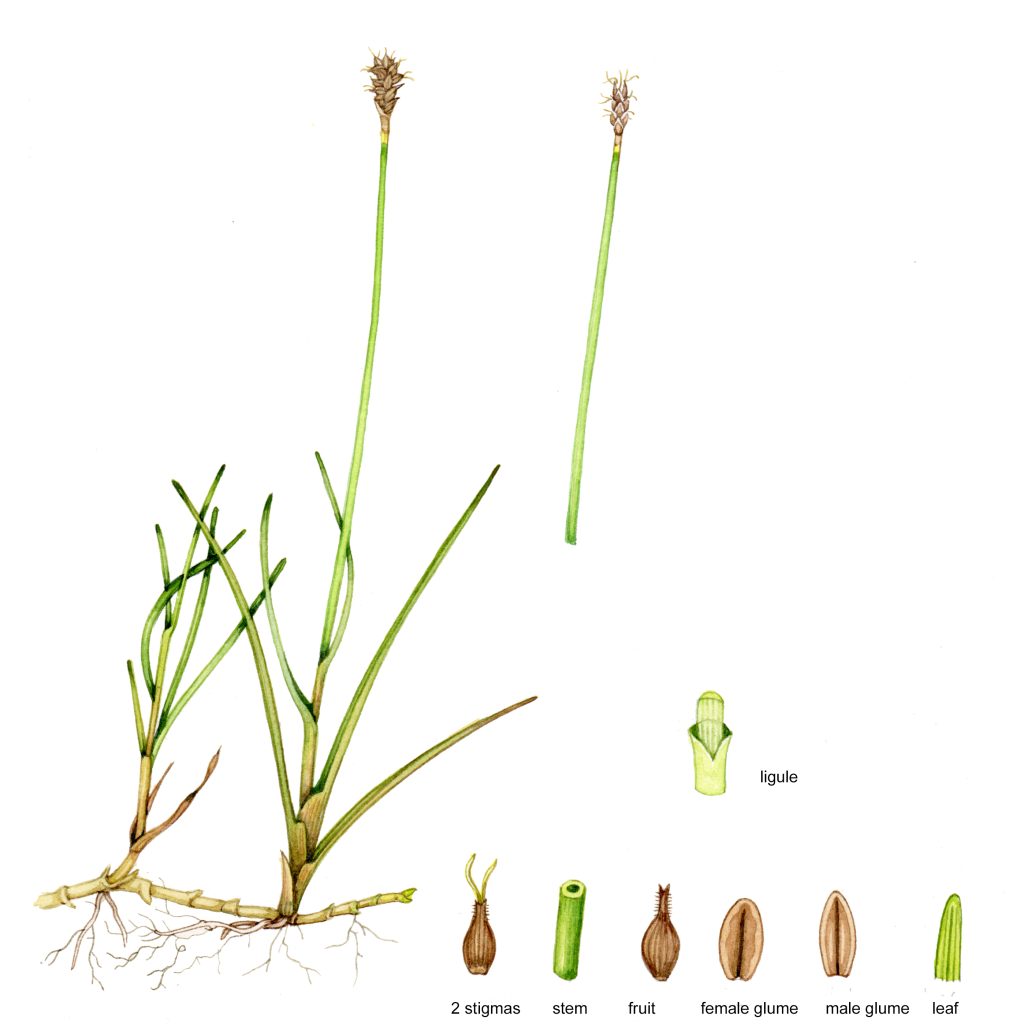
Different unisex florets appear on different plants in Diocecious sedge Carex dioica
This arrangement of the tiny spikelets, and whether they’re bisexual, male or female is the bit of sedge anatomy I find most confusing!
Nutlets or fruit of sedges
The fruits or nutlets of sedges are vital when it comes to telling species apart. Their shape and size matters. The absence or presence of a beak is important. Shape of a beak (if present) is vital. Colour, hairiness (or not), and presence or absence of veins are all important.
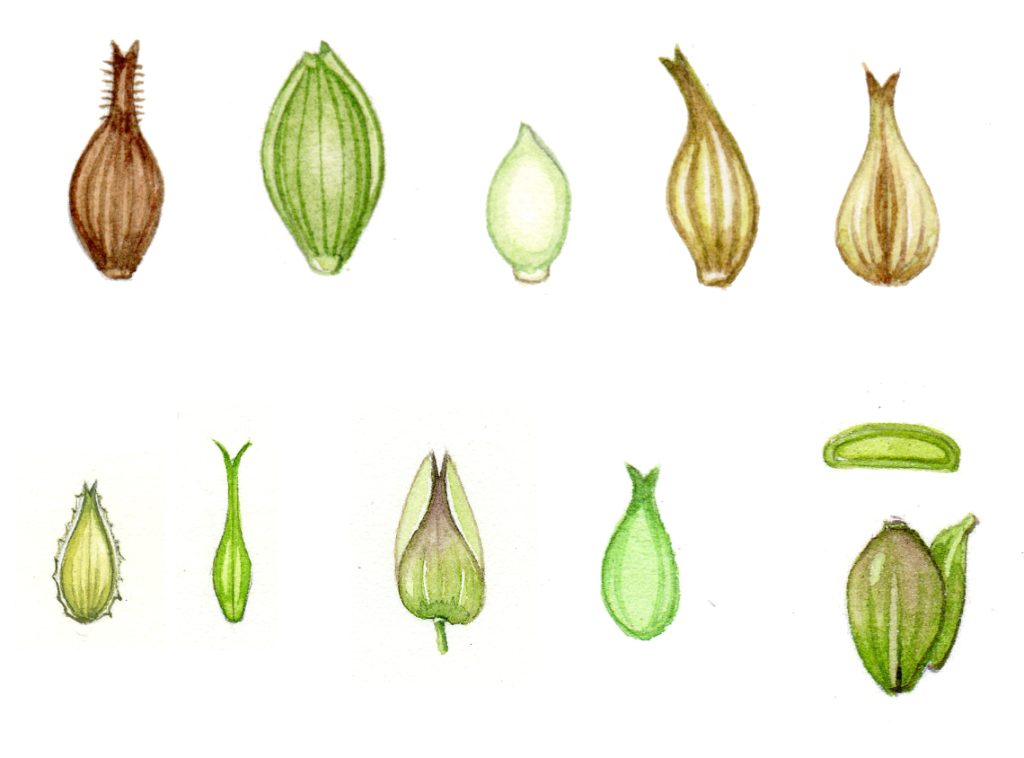
diverse selection of sedge fruit or nutlets
Variety
The variety of sedges is amazing. It includes beautiful species resplendent with white bristles such as the cotton grasses Eleocharis. Then there are elegant drooping plants like the Pendulous sedge Carex pendulosa and the blueish Glaucous sedge Carex flacca. Unobstrusive species that resemble rushes like the Black bog rush Schoenus nigricans are lovely, too. Large plants with toothed leaf blades like the Great fen sedge Cladium mariscum are dramatic representaives. There are what I think of as “typical” sedges like the Stiff sedge Carex biglowii. Don’t forget deauties with extraordinary fruit (like the Bottle and Star sedge, Carex rostratum and echinata respectively.)
Below is an array of these fine plants. I’ve been commissioned to paint these by the Field for School Studies. They appear on fold-out guides to different habitats.
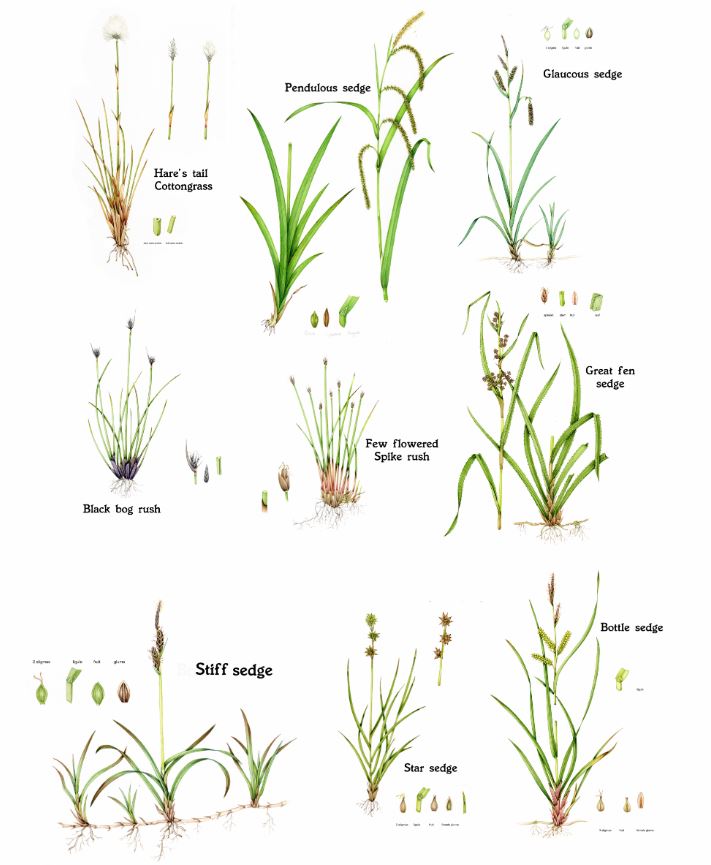
A small variety of the more than 5,500 species of sedge
Identifying sedges
There are several things to consider when trying to identify a sedge to species level. Think about how it grows from the rhizome. Consider leaf width, length and colour. Lok at leaf ligules. Where is it growing (habitat)? What size is the plant? See whether it has separate male and female flowers. Look for details of the spikelets.
With Carex species, you first and foremost need to consider the nutlet or fruit.
Glumes, at the base of the spikelet, need to be examined and the colour and shape considered.
Bracts (below the spikelet) need a close examination.
Figure out if there are two or three stigmas on the flowers.
Look to see how the flowers are arranged on the plant. Both their position on the stem and in terms of where female and male flowers sit if relevant.
References
I love sedges, although I readily admit to being almost a total novice when it comes to identifying them in the field. There are some splendid courses on sedge identification out there (like the Field Studies Council one, which I blogged about attending last year); and for the British Sedge species some very useful books. These include the “bible” for Uk sedge identification, Sedges of the British Isles by Jermy, Simpson, Foley & Porter. It’s published by the Botanical Society of the British Isles and is a hefty and very comprehensive volume, complete with a lot of detailed information on growth and anatomy in the opening pages, and distribution maps for each species.
I also find the Colour Identification to the Grasses, Sedges, Rushes and Ferns by Francis Rose very helpful and clear, along with Collins Guide to the Grasses, Sedges, Rushes and Ferns by Fitter, Fitter and Farrer. The sedge section in Collins Flower Guide by Streeter has some very good illustrations by Christina Hart-Davies. For a comprehensive if dry resource, look at the Flora of the British Isles by Clapham, Tutin and Moore.
Diagrams in this blog owe a lot to the incredibly helpful The Cambridge Illustrated Glossary of Botanical Terms by Hickey and King .
I do hope that this introduction to the beautiful sedges will have inspired some of you to go out and start looking at these beautiful and frequently overlooked plants. Along with grasses, and rushes, they’re proving to be really fascinating; both to learn about and to illustrate.


I think I have a fossil sedge. It’s like stone and more fossil like. It is shaped like a small bush but hand sized . Each branch rises from a center and each seperate branch is triangle shaped . My fossil is about 3-4 inches high no sign of branches but itself looks woody and branching are hollow. The base is in a matrix like rock which may have been dirt at one time.So root may be there just hidden. I just wondered if you know anyplace in the Ithaca or Elmira area to have this identified. Thank you Sincerely, Mrs Tina Pratt
Hello Tina
That sounds fascinating, wouldn’t it be great to have it i.d.? I’m thinking the natural history museum in NYC might help, or the one in DC/ I don’t necessarily mean for you to go on a quest, but you could maybe send out some emails or give them a ring and ask to speak to someone in the botany and/or paleontolgy departments? I’m sure a few good photos from a phone or similar could go a long way to helping decide whether or not you;ve got a fossilized sedge on yoru hands? Another idea is that if you do have a few good photos, then you could ask on Twitter? If you’re not on Twitter Id be happy to put it out there on your behalf and see if any paleo-botanists can help out? If you want, feel free to send me a couple of photos to info@lizzieharper.co.uk and I’d be happy to see what I can do to help. In the meantime, good luck with your quest, and how lovely to own such an exciting thing!
Excellent accurate botanical drawings Lizzie and not fuzzed by the artistic licence of some plant illustrations that make identification very difficult. I would guess drawn from real life specimens?
Hi Paul
Thanks so much, I very much appreciate your comment. As much as possible I do work from real life. If I cant, or the plant is rare, then I work from lots of different sources to try and iron out inconsistencies. I also wotk closely with written descriptions which, though dry, are really helpful.
thanks again
x lizzie
Dear Lizzie,
I have just come across your site while trying to identify a sedge.
Your work is just stunning, I love it..
I have always been keen on grasses, and love their shape and form. I post daily on my facebook page photos of “Flowers on the Croft” (I’m in NW Scotland). I also have a good selection of wild flower books, including some of the Bentham and Hooker British flora’s, some of the black and white illustrations have been water coloured, and are much treasured. Also worth looking out for “Favourite Field Flowers” by Robert Tyas, my 1848 edition has twelve delightful coloured plates.
Still haven’t ID’d the sedge, but your pages have brightened my day,
Thank you
Hi Peter
Oh, those refence books sound wonderful. Living in Hay on Wye, I might be able to scout around and see if any are available…although they sound like they’re rather valuable. Hooker and Bentham eh? Wowzers. But the Tyas Id not heard of, and will def be looking up. Good luck with the sedge. Although rather dry, the BSBI sedge handbook by Simpson and Porter is useful. As is twitter – if you have a photo you could pop it onto twitter, tag @wildflowerhour and ask for an i.d. I bet you the botanical community would give you a name within hours!
Thanks for the recommendations, and the positive feedback!
Yours
Lizzie
Lizzie,
You have acheived your goal of illustrating and explaining the features of sedges, so that instead of seeming dull , they seem fascinating and understandable. Thanks so much; your art is exquisite.
Oh Katherine, that is a lovely comment! Sedges are stunning, and so easy to ignore. All of these little gems of nature are glorious when we’re lucky enough to have the time to look at them closely….
i read all your 3 blogs on rushes, sedges and grasses……it was an absolute delight and uncomplicated explanation for a novice like me. Thankyou ! and the illustrations are beautiful
Hi Priti
This is excellent news! I feel that the subject shouldn’t be complicated, it just feels a bit overwhelming. Im far from being an expert. But I love that my blogs have helped you get your head round these super-cool plants. And thanks for leaving a comment!
Hi Lizzie.
I’ve been volunteering at my local nature reserve for the last 10 months and I’ve been wanting to improve my knowledge on grasses, sedges and rushes.
I came across your article on sedges following a Google Search and subsequently found those on grasses and rushes that were linked in Sedges article.
Congratulations are due to you on the format and content of these articles and I just wish I’d come across them sooner! The illustrations are amazing.
Well done and keep up the good work.
Hi Joe
Oh Im so glad they’re useful! i go on courses, or study and learn something new, and then Ill blog about it as a way to get the information stuck in my head, and so I can re-learn it when Ive (inevitably) forgotten it all! That’s great to hear that you find the blogs useful. And well done for your volunteering! They’re lucky to have you.
Yours
Lizzie
Beautiful blog with illustrations, I try to find out which type of sedge I got from Freecycle, after a series of googling I’m glad I found this blog!
Oh man, knowing if a plant is a grass or sedge is one thing. but getting a species identified is something I’m not much good at, with sedges! But I love the idea of getting sedge off freecycle, what an excellent thing to do.
Brilliant illustrations, hope you can do some more of those pesky little sedges like C.disticha and be so nice of you could show them in autumn state when none of the fruiting bits are available and they have turned colour.
I used to work as. full time botanist and could identify all of these but Ive forgotten them now. Ive just completed an art degree and would love to get involved in illustrating some of the difficult ones. if you need help with a book!
Cheers
liz
Hi Liz
Wow, that would be quite the project; a book of sedges in vegetative states. I love the idea of it, but truly doubt I have the skills to do such a thing. Nor (lets face it) do I think even the most esoteric of natural history publishers would fund such a niche project. The world would be a better place if they did, though! And if ever they DO decide to create something like this, and if by chance they want me on board…then I would totally follow you up for advice, help, drawings and (probably) counselling!
Such a great idea, I love it. And I may actually do some grasses and sedges not in flower or fruit. You’re right, it would be interested and useful.
yours
Lizzie
What a wonderful introduction to sedges! It’s true that these plants often don’t receive the attention they deserve, but your post highlights their elegance and beauty. Exploring their anatomy and diversity can truly unveil their charm to people. I appreciate the effort to provide a beginner’s guide to sedges, as it’s a great way to ignite curiosity and appreciation for this distinct group of plants. Looking forward to learning more about them!
Thanks for the comment, Parker. Im glad you sure my interest in this lovely group of plants. x
Good evening, I am doing a project on the sawgrass sedge (Cladium jamaicense Cranz). The project is pretty open-ended so I would like to include a little bit about the evolutionary aspects of the sawgrass, specifically the advantages that come with having sharp teeth edges. Unfortunately, I have not been able to find any papers or research done on the reason for sharp-edged sedges. Say that three times. I’m looking forward to your response! 🙂
Hi Dylan
I havent researched the benefits of sharp-edges for plants, although Im sure they deter predation from herbivores. What else? Maybe something to do with environmental conditions? Tell you what, if you do research and come up with some good answers, drop me an email. I’d be up for publishing an edited version of your project (along with a link to you or your research) as a blog if that appealed? My email is info@lizzieharper.co.uk
Great job for publishing such a nice article. Your article isn’t only useful but it is additionally really informative. Thanks
It is truly a well-researched content and excellent wording. I got so engaged in this material that I couldn’t wait to read. I am impressed with your work and skill. Thanks.
This is beautiful! Thank you so much!
Thanks for the comment. And fingers crossed you use loads of sedge in your landscape architecture projects, the larger species are so structural, arent they?